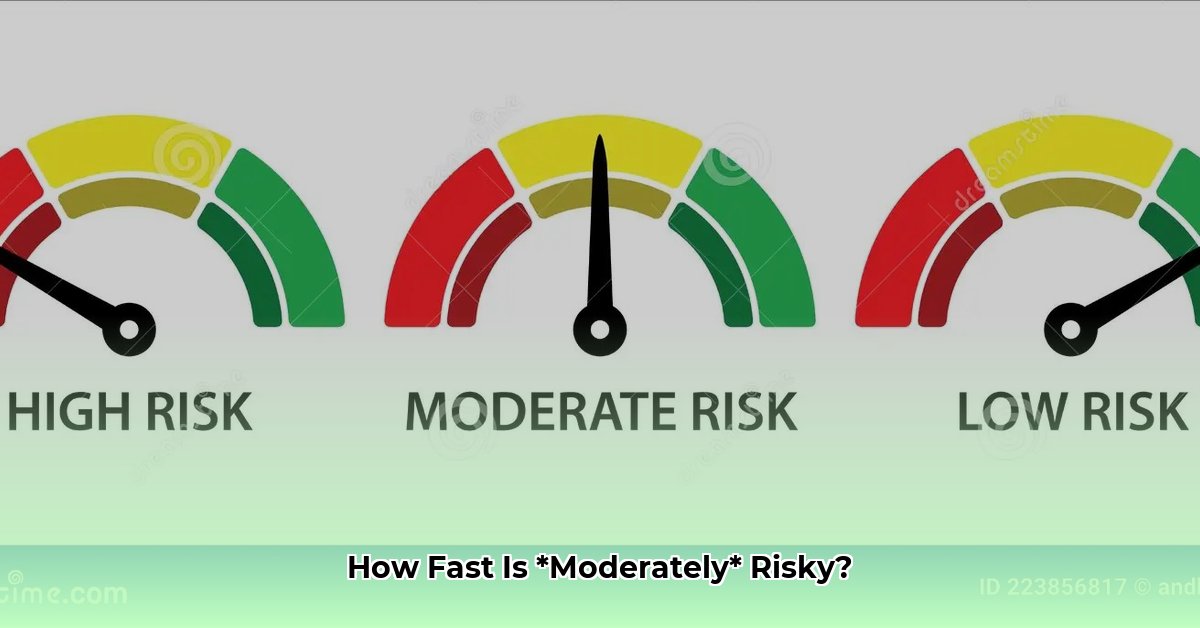The Hidden Dangers of Moderate Speeds
We all know speeding is dangerous, but what about those seemingly “safe” speeds below 50 mph? This guide explores how even moderate speeds significantly impact road safety. We’ll examine the science behind crashes, the role of speed in reaction time, and the often-overlooked hazards on various roads. This information will empower you to make safer driving choices, regardless of the conditions.
Why Speeds Below 50 mph Still Matter
Driving always carries some level of risk. While high-speed highway driving is clearly dangerous, the “moderate” risk zone below 50 mph often gets overlooked. This speed range, common on city streets, residential roads, and some rural routes, presents unique challenges. Drivers may feel more comfortable at these speeds, but significant hazards remain. Let’s explore why “moderate” doesn’t equal “no worries.”
“Moderate” Risk: Not Risk-Free
Even at lower speeds, collisions can have serious consequences. Would you intentionally run into a wall at 30 mph? Probably not. The force of impact at even these seemingly moderate speeds can cause significant damage. “Moderate” simply means a lower risk compared to higher speeds, but it’s still a risk worth taking seriously.
The Physics of Speed and Impact
The danger of speed boils down to kinetic energy—the energy of motion. The faster an object moves, the more kinetic energy it has. In a collision, this energy is released suddenly, often with destructive results. Even at moderate speeds, the kinetic energy can be surprisingly high, causing significant vehicle damage and potential injuries. Shorter stopping distances at lower speeds offer some protection but don’t eliminate the risk.
Beyond Speed: Other Factors
Speed significantly influences risk, but it’s not the only factor. Driver behavior, such as distractions, impatience, and ignoring traffic laws, can amplify the danger at any speed. Road conditions, weather, and visibility also play crucial roles. It’s a complex equation: speed combined with these factors determines the overall risk level.
Real-World Scenarios: Moderate Risk in Action
Imagine driving 40 mph on a busy street when a pedestrian suddenly appears. Or picture a school zone with children darting around. These are classic moderate-risk scenarios. Even though the speeds are lower than highway driving, the potential for a collision remains substantial due to the unpredictable nature of these environments.
Navigating the Moderate-Risk Zone
How can we navigate this often-underestimated risk?
- Situational Awareness: Constantly scan your surroundings for potential hazards like pedestrians, cyclists, and obscured intersections.
- Speed Management: Adjust your speed to the conditions, not just the posted limit. Lower speeds provide more reaction time.
- Focus: Eliminate distractions, maintain eye contact with the road, and anticipate potential hazards.
Safe driving is about managing and minimizing risk, not eliminating it entirely.
General Risk Levels by Speed (A Simplified View)
| Speed Range | General Risk Level | Typical Environments |
|---|---|---|
| Under 30 mph | Lower | Parking lots, residential streets |
| 30-50 mph | Moderate | City streets, school zones, some rural roads |
| Over 50 mph | Higher | Highways, freeways |
This table simplifies a complex issue. Actual risk depends on a combination of factors. Use it as a starting point, but always adjust your driving to the specific situation.
Moderate Speed Dangers: Hidden Hazards
While high-speed driving is obviously dangerous, moderate speeds, typically under 50 mph, present unique challenges. These lower speed zones, common in urban and suburban areas, can be surprisingly hazardous due to a higher concentration of potential dangers.
Intersections: A Common Crash Site
Intersections are a constant threat at moderate speeds. Even with a green light, another driver might run a red light, or a pedestrian could unexpectedly cross. Approach intersections cautiously, scan the area, and be prepared to brake.
Sharing the Road with Vulnerable Users
Moderate speed zones often involve sharing the road with pedestrians and cyclists. At these speeds, a near miss can easily become a serious collision. Drivers must be extra vigilant and anticipate the unpredictable movements of these vulnerable road users. Reducing speed in these areas provides crucial reaction time.
Tailgating and Lane Changes: Increased Risks
Tailgating, even at 30 mph, significantly increases the risk of a rear-end collision. Changing lanes in moderate speed traffic requires careful observation and clear signaling. Don’t assume other drivers will anticipate your actions.
Distracted Driving: A Persistent Danger
Distracted driving remains a serious threat at any speed. At 40 mph, your car travels almost 60 feet per second. A brief distraction can have disastrous consequences. Prioritize safety by staying focused.
The Impact of Small Speed Increases
Even slight increases in speed can significantly impact crash severity. Higher speeds mean longer stopping distances and reduced reaction time. Respect posted speed limits.
Safe Driving at Moderate Speeds: Constant Vigilance
Safe driving in moderate-speed environments requires constant risk assessment and adaptation. Continuously scan your surroundings, anticipate potential dangers, and adjust your speed and following distance accordingly. Complacency can be your greatest enemy. Stay informed about ongoing research into driver behavior and adapt your driving practices accordingly.
The Deceptive Nature of Moderate Speeds: Why They’re Dangerous
Speeds below 50 mph, often encountered on city streets and residential roads, account for a significant number of accidents. These speeds define “moderate driving risks,” which can be deceptively hazardous. Complacency at these lower speeds is dangerous.
Reaction Time and Stopping Distance: The 40 mph Example
Consider driving 40 mph down a residential street. If a child runs into the road, do you have enough time to react? Probably not. While 40 mph may not seem fast, your stopping distance is significantly longer than at 30 mph, and your reaction time is likely insufficient to avoid a collision. Some experts suggest even 35 mph can pose substantial risks in areas with pedestrians. Ongoing research continues to explore the relationship between speed and accident severity.
The Physics of Impact: The Exponential Increase
The force of impact isn’t linear; it’s exponential. A car traveling at 45 mph carries significantly more kinetic energy than one at 30 mph, resulting in a much greater force of impact and increased likelihood of serious injury. Ongoing research is investigating how these forces affect the human body at moderate speeds.
Moderate vs. High-Speed Dangers: Different but Still Dangerous
High-speed crashes are often catastrophic. Moderate-speed collisions, while not always as dramatic, still pose significant danger. They can cause injuries like whiplash, broken bones, and concussions. Current studies are examining the long-term effects of these crashes, including the potential for chronic pain.
Mitigating Risks at Moderate Speeds: Essential Tips
Managing speed is crucial for the safety of everyone on the road. Stopping distances and impact forces are significantly greater at higher speeds, leaving less time to react and increasing the risk of severe injury. Even small increases in speed can dramatically increase accident severity.
Protecting Vulnerable Road Users
Pedestrians, cyclists, and motorcyclists are especially vulnerable. A collision at even a “moderate” speed for a car can be devastating for them. Reducing speed in areas shared with these users is essential.
The Role of Road Design
Road design influences speed. Narrow, winding roads encourage slower speeds, while wide highways can tempt drivers to speed. Traffic calming measures like narrower lanes, speed bumps, roundabouts, and traffic circles can physically encourage lower speeds, making roads safer for everyone. Dedicated bike lanes and pedestrian crossings provide essential protection.
Education and Enforcement: A Two-Pronged Approach
Public awareness campaigns can inform drivers about the dangers of speeding, while enforcement measures like speed cameras and police patrols deter speeding. This combination promotes safer driving habits.
Technology: Advanced Driver-Assistance Systems
ADAS features like adaptive cruise control and automatic emergency braking can help drivers maintain safe following distances, slow down in hazardous situations, and prevent collisions. While valuable, these systems are supplemental; drivers should remain attentive.
A Shift in Thinking: Prioritizing Safety Over Speed
We need to shift our focus from moving traffic quickly to prioritizing safety. Shaving minutes off a commute shouldn’t compromise safety. This shift may mean accepting longer travel times but creates a safer environment for everyone. Experts believe this requires infrastructure improvements, stricter enforcement, public education, and changing social norms. Ongoing research explores how to encourage safer driving and prioritize road safety.
Key Factors Affecting Safety
| Factor | Impact on Safety |
|---|---|
| Increased Speed | Longer stopping distances, reduced reaction time, greater impact force |
| Vulnerable Road Users | Pedestrians, cyclists, and motorcyclists are at significantly higher risk |
| Road Design | Traffic calming measures encourage lower speeds and enhance safety for all users |
| Education & Enforcement | Raising awareness and enforcing consequences |
| Technology | ADAS systems offer additional safeguards |
| Prioritizing Safety | Shifting focus from speed to safety leads to more responsible driving behavior |
Our understanding of speed and safety is constantly evolving. Stay informed about new research and adapt your driving practices accordingly.
How Speed Affects Reaction Time and Collision Severity: The Physics of Danger
Speed is crucial to road safety because it significantly affects a driver’s ability to react to unexpected hazards and the severity of a collision if one occurs. This isn’t just about avoiding tickets; it’s about understanding the real-world physics that can mean the difference between a close call and a tragedy.
The Bowling Ball Effect: Understanding Momentum
Imagine stopping a slowly rolling bowling ball versus one hurtling down the lane. The faster ball has much more momentum and is significantly harder to stop. The same principle applies to cars. Higher speeds mean more energy, leading to a more forceful impact in a crash.
Reaction Time: The 1.5-Second Rule
Reaction time – the time to perceive, process, and react to a hazard – is about 1.5 seconds on average. At 30 km/h (19 mph), you’ll travel approximately 13 meters before braking. At 50 km/h (31 mph), that distance increases to over 21 meters. Those extra meters can be the difference between a near miss and a collision. Factors like fatigue, distractions, and age can further lengthen reaction time.
Crash Severity: The Force of Impact
Speed dramatically impacts crash severity. A glass dropped from a counter might break, but one dropped from a rooftop will shatter. Similarly, higher speeds mean more violent impacts and a greater likelihood of serious injury or death. Studies suggest a roughly 10% risk of serious injury at 30 km/h in head-on or right-angle crashes. This risk increases dramatically with speed.
Approximate Risk of Serious Injury
| Impact Speed (km/h) | Impact Speed (mph) | Crash Type | Risk of Serious Injury (Approximate) |
|---|---|---|---|
| 30 | 19 | Right-angle/Head-on | ~10% |
| 50 | 31 | Right-angle/Head-on | Increases significantly (Research varies) |
| 70 | 43 | Right-angle/Head-on | Very High |
These are estimates, and real-world scenarios depend on various factors. However, the trend is clear: higher speeds mean more dangerous crashes.
The Safe System Approach
The “Safe System” approach acknowledges that human error is inevitable and aims to create a more forgiving system. This involves managing speed, designing safer roads, and implementing stricter traffic laws. It’s about recognizing that even small speed increases can have significant consequences. Remember the bowling ball analogy and prioritize safe speeds.
- How Glass Bento Box Containers Make Meal Prep Easier - December 18, 2025
- Why Glass Boxes for Lunch Are Trending for Meal Prep - December 17, 2025
- Bento Box Glass Offers Practical, Eco-Friendly Meal Storage - December 16, 2025










